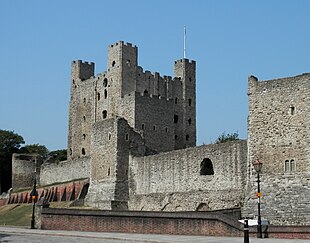
A keep is a type of fortified tower built within castles during the Middle Ages by European nobility. Scholars have debated the scope of the word keep, but usually consider it to refer to large towers in castles that were fortified residences, used as a refuge of last resort should the rest of the castle fall to an adversary. The first keeps were made of timber and formed a key part of the motte-and-bailey castles that emerged in Normandy and Anjou during the 10th century; the design spread to England, Portugal,[2] south Italy and Sicily. As a result of the Norman Conquest of England in 1066, use spread into Wales during the second half of the 11th century and into Ireland in the 1170s. The Anglo-Normans and French rulers began to build stone keeps during the 10th and 11th centuries, including Norman keeps, with a square or rectangular design, and circular shell keeps. Stone keeps carried considerable political as well as military importance and could take a decade or more to build.
During the 12th century, new designs began to be introduced – in France, quatrefoil-shaped keeps were introduced, while in England polygonal towers were built. By the end of the century, French and English keep designs began to diverge: Philip II of France built a sequence of circular keeps as part of his bid to stamp his royal authority on his new territories, while in England castles were built without keeps. In Spain, keeps were increasingly incorporated into both Christian and Islamic castles, although in Germany tall fighting towers called bergfriede were preferred to keeps in the western fashion. In the second half of the 14th century, there was a resurgence in the building of keeps. In France, the keep at Vincennes near Paris began a fashion for tall, heavily machicolated designs, a trend adopted in Spain most prominently through the Valladolid school of Spanish castle design. Meanwhile, tower keeps in England became popular amongst the most wealthy nobles: these large keeps, each uniquely designed, formed part of the grandest castles built during the period.
In the 15th century, the protective function of keeps was compromised by improved artillery. For example, in 1464 during the Wars of the Roses, the keep of Bamburgh Castle on the Northumberland coast, previously considered to be impregnable, was defeated with bombards.[3] By the 16th century, keeps were slowly falling out of fashion as fortifications and residences. Many were destroyed in civil wars between the 17th and 18th centuries or incorporated into gardens as an alternative to follies. During the 19th century, keeps became fashionable once again, and in England and France, a number were restored or redesigned by Gothic architects. Despite further damage to many French and Spanish keeps during the wars of the 20th century, keeps now form an important part of the tourist and heritage industry in Europe.
- ^ 1336100
- ^ Barroca (1991), p. 121
- ^ Bottomley, Frank (1983). The Castle Explorer's Guide. Crown Publishers. ISBN 0-517-42172-0.